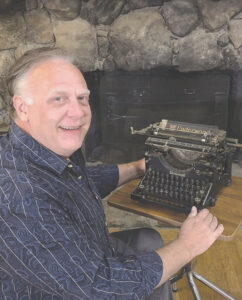Our Special Valentine
(Story provided by Craig Durst)
It’s several days before Valentine’s Day and the Crescenta Valley Weekly time machine has just transported you back to the year 1872. You see a young married couple in the living room of their home in New Brunswick, New Jersey. The woman, Hetty, is laughing as her husband Charles dangles his wedding ring from a chain above her very pregnant belly. “It swung back and forth, not in a circle,” he excitedly exclaimed. “It will be a boy then – no doubt.”
In those days there was no way of determining with certainty the sex of your unborn child. The gold ring method was one of the more common attempts. On Valentine’s Day of that year Hetty gave birth to a son. The couple chose the name Marshall for their new baby boy but something unusual had occurred. Just years before, his brother Charles had been born on the very same holiday. Perhaps once was a coincidence, but two Valentine babies? The moment was memorialized when they inscribed his full name on the birth certificate, “Marshall Valentine Hartranft.”
Fast forward 30-plus years and Marshall has become a beloved character in our valley. He and his wife Louise are referred to as Uncle Marsh and Aunt Lou. On this particular day in 1909 they are welcoming a guest from San Diego – Mr. William Ellsworth Smythe – to their Sunland property. The Lazy Lonesome Rancho they called it, and it sat at the base of the Verdugo Hills just west of Sherman Grove Avenue.
“I’m the lazy one and Aunt Lou, the lonesome,” Marsh would say. Louise would point out that being lazy was more of an aspiration for her husband as she was only lonely due to his non-stop work habits.
They made their way out onto the large porch surrounding the north end of the house where a Victrola played quietly. The conversation that then began would lead to the founding of the Los Angeles Little Landers Colony, which would evolve into the present-day town of Tujunga.
“The most valuable of all arts is that of deriving a comfortable subsistence from the smallest area of soil, that’s what Abraham Lincoln used to say,” William started off, “and that’s what we Little Landers do best, Marshall.”
Just a year prior, in 1908, Smythe had founded the first Little Landers Colony just 15 miles from San Diego and the movement quickly flourished. “A little land and a living” was their mantra and also the title of a book written by New York author Bolton Hall. His writings served as a relative guidebook to the efforts of getting the absolute most yield from a small parcel of land.
Uncle Marsh had acreage east of Sunland on the stone strewn barren slopes there. This is where the new colony would emanate. The settlement would have several unique components. First, a clubhouse would be built for colony business and social engagements. As the area was blanketed with stone the choice of building material was quickly made, and construction began. The clubhouse was completed in late 1913 and soon a cooperative store began to rise on the opposite corner. Lastly, as W. E. Smythe was an expert in the field of irrigation, water was piped in and delivered to many of the prime lots that would be offered for sale.
Years earlier, Hartranft had begun publishing a farm journal called The Western Empire and distribution had expanded nationally. Marshall began advertising colony lots for sale: “The Little Lander proposes to have for himself and his loved ones every enviable thing which is within reach of the millionaire!” With claims like that, payments began to arrive for lots, sight unseen.
The philosophy and ideas that underpinned the Little Landers movement were quite interesting and, in some cases, seemingly genius. Next time, we’ll go deeper into the utopian mindset of these Little Lander colonists.

